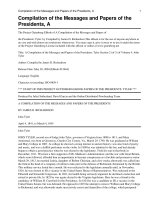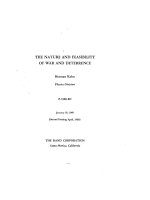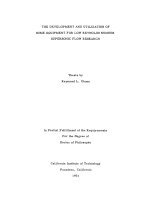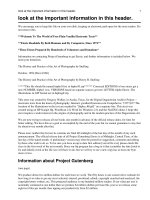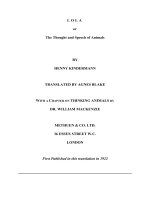Slides 13 1 determine the purpose and characteristics of rol
Bạn đang xem bản rút gọn của tài liệu. Xem và tải ngay bản đầy đủ của tài liệu tại đây (4.11 MB, 48 trang )
Determine the Purpose and
Characteristics of Role Based
Cost Management and Control
© Dale R. Geiger 2011
1
All the World’s a Stage:
What’s Your Role?
© Dale R. Geiger 2011
2
Terminal Learning Objective
• Task: Determine the Purpose and Characteristics of
Role Based Cost Management and Control
• Condition: You are training to become an ACE with
access to ICAM course handouts, readings, and
spreadsheet tools and awareness of Operational
Environment (OE)/Contemporary Operational
Environment (COE) variables and actors
• Standard: with at least 80% accuracy
• Define the characteristics of Role Based Control
• Discuss dimensions of cost reporting
• Apply ABC concepts to Role Based Control situation
© Dale R. Geiger 2011
3
Different Types of CMOs
Role Based vs. Org Based Control
• Organization based control exploits the
reporting relationship of the org chart
• Sometimes we wish to manage and control
joint efforts where reporting relationships
don’t exist
• Organizations that support but don’t report to the
supported core functions
• Organizations that come together for a specific
purpose like ARFORGEN or training
© Dale R. Geiger 2011
5
Support Functions Often Do Not
Report to Core Functions
• Consider a common organization where support and
core functions report on the same level
Headquarters
Core A
Core B
Support X
Support Y
Support Z
• Core functions do the major missions
• Support functions aid the core functions and only
indirectly support the major missions
© Dale R. Geiger 2011
6
Budget Often Funds Each Component
Separately, Creating “Stovepipes”
• Support functions are often funded independently of
their roles and responsibilities to the core orgs
Core A
Core B
Support
X
Support
Y
Support
Z
• Over time they can forget their supporting roles
© Dale R. Geiger 2011
7
The Problems with Stovepipes
• Support budget is independent of support
provided
• Result: less supportive of core org customers
• Support is “free” to customers
• Result: “free” goods have infinite demand from core
organizations
• Bottom line
• More cost than appropriate in support functions
• Support functions disconnected from their support
role
Solution: Role Based Control
• Goal:
• Build cost control process around the support and
supported roles
• Solution:
Solution
• Create forum of interaction through AAR
structured so that support functions present costs
and continuous improvements to core functions
• Requirement:
Requirement
• Measurement process that assigns virtual support
“costs” to consuming core functions
Role Based Control Goal Results: A
Virtual Organization
Headquarters
Core A
Core B
AAR
X
Y
Z
X
Y
Z
Where support functions are now part of each core team
Cost View vs. Budget View
Headquarters
Headquarters
Core A
Core B
Core A
Core B
Support
X
Support
Y
Support
Z
AAR
X
Y
Z
X
Y
Z
© Dale R. Geiger 2011
11
Role Based Control
• Facilitates the creation of this virtual
organization
• Key is the after action review
• Support leaders present to core leaders and senior
leader
• Support leaders show results and continuous
improvement initiatives just as in the organization
based AAR
Role Based Control
• Major Strengths
• Relatively few people involved in AARs
• New cost based focus on the “enterprise” mission
• Powerful insights and interactions result
• Major Challenges
• Need to determine the cost of each support
function’s cost for each core function
• This costing process has numerous choices and
pitfalls
Role Based Costing Issues
• Most organizations have
• Thousands and thousands of things that could be
measured
• and
• thousands of ways to measure them!
• How does one decide which things and ways
to systematize?
• New accountability relationships do NOT
necessarily require new accounting relationships
Learning Check
• How does role-based control differ from
organization-based control?
• What are the benefits of implementing rolebased control?
© Dale R. Geiger 2011
15
Individual Study
• Read paper: New Directions for Cost Reporting
What Costs Should be Considered? Defining
the Cost Measurement Process
• General guidance:
• It doesn’t make sense to spend a lot on costing
process when the goal is to be more cost effective
Frequency
Scope
Flavor
Fullness
•
•
•
•
Costing can always be done more frequently
Costing can always be done in greater detail
Some cost views are more useful than others
Costing can always include more components
Frequency Issues
• The cost of the control process is the sum of
the measurement cost and the process cost
• More frequent meetings increase both
• Choices:
•
•
•
•
•
Event Driven
Daily
Weekly
Monthly
Quarterly
Scope Issues
• There is a point where the cost of greater detail
exceeds the value of greater detail
• The goal is to reasonably approximate the cost
of things that matter
• Choices:
• Number of activities considered in the support orgs
• Organization level of the core functions considered
to be cost objects
• Complexity of allocation process
Flavor Issues
• Different cost views exist to fill different
intelligence needs
• What cost view provides best intelligence in
support of Commander’s Intent?
• Choices:
• Controllable versus non-controllable
• Total versus incremental
• Fixed/Variable vs. Direct/Indirect
Fullness Issues
• Cost considerations must be bounded to
exclude elements that don’t support goal
• Example, every cost in the Army should include
an allocation from the Commander in Chief if
truly “full”
• Choices:
• Allocations from Brigade, Division, Corps, etc
• Allocations from personnel, resource mgmt,
chaplain, etc
Learning Check
• What are the four dimensions of cost to
consider when defining the cost control
process?
• What two considerations govern the decision
of what to include in cost measurement?
© Dale R. Geiger 2011
22
Role Based Control Needs a
Consumption Based Allocation
• Traditional accounting
• Provides the elemental data on input or source
cost
• Consumption based allocation
• Pools cost data into activities
• Develops drivers based on consumption of the
activity
raw accounting data
cost pool
activity
Managerial Costing Terms
raw accounting data
cost pool
managerial
costing
translation
method
of
distribution
=
managerially useful information
Allocation Costing Terms
cost pool
activity
method
of
distribution
allocation
based on
cost driver
=

